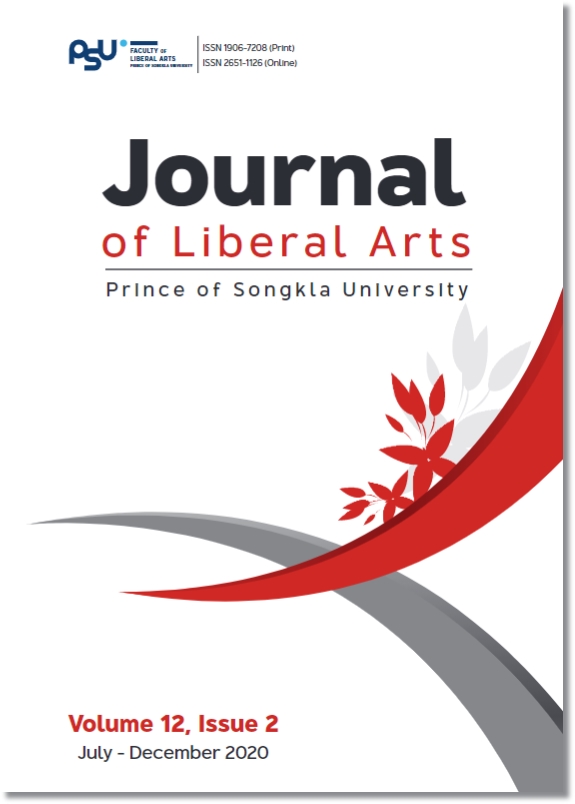The Khunolay and Muealay Cliff Stones: The Roles of Oral Literature and Natural Folk Objects Reflecting the Worldviews of Pga K’nyau People at Kosotha Village in Mae Chan Sub-District, Umphang District, Tak Province
Keywords:
natural folk objects, oral literature, Pga K’nyau, worldviewAbstract
This research aims to study the oral literature “Khunolay Muealay” found to be related to the Khunolay and Muealay cliff stones, which are considered as natural folk objects. The roles of the oral literature and the cliff stones incredibly reflect the prominent worldviews of the Pga K’nyau hill tribe at Kosotha Village in Mae Chan Sub-district, Umphang District, Tak Province, Thailand.In conducting this qualitative research, descriptive analysis was used to present the findings and the concept of roles of oral literature in natural folk objects was also adopted as the framework of this study. With regard to the findings, the oral literature “Khunolay Muealay” and the cliff stones considered as natural folk objects are two significant elements that reveal four worldviews of the Pga K’nyau hill tribe. The first worldview reveals that Pga K’nyau people admire the love that their ancestors, Khunolay and Muealay, had for each other. The second worldview reflects their respect for the forest, particularly where the cliff stones stand. In other words, they believe that the area is sacred and therefore should never be invaded. The third worldview represents their worship of nature-related gods believed to be present in the forest and the cliff stone area, whereas the last worldview reveals that Pga K’nyau people are immensely proud of their identity and roots
References
Aeusrivongse, N. (1993). The hero in Thai culture. In The 4th Special Occasion Speech for Puey Ungphakorn. Thammasat University.
Bronner J, S. (1986). Folk groups and folklore genres: An introduction. Logan, Utah: Utah State University Press. file:///C:/Users/LA/Downloads/Documents/BronnerFolkObjects_2.pdf
Chaithongdee, C. (2014). Sacred narratives and the cultural area formation in Sisaket Province. Journal of Humanities and Social Sciences Burirum Rajabhat University, 6(2), 72-89.
Inpakdee, N. (2016). Creative folklore derived from Khru Mo Nora beliefs in Tambon Takea, Changwat Phatthalun [Unpublished master’s thesis]. Chulalongkorn University.
Kengphanich, S., Gasorngatsara, S. & Boonyasurat, W. (2016). Management of the Sacred Mountain of Wat Mon Phraya Chae for pilgrimage and cultural tourism. International Conference on Research and Design in Architecture and Related Fields 2016, 13(1), 125-158.
Kongsirirat, S. (2014). The Laotian’s worldview about leaders from proverbs. Mekong-Salween Civilization Studies Journal, 5(2), 107-135.
Krumram, P. (2013). A study of worldviews in external reading books for high school students. Ramkhamhaeng University.
Loppawong, N., & Panyanuwat, A. (2014). Management process for retaining cultural identity of the Pga K’nyau ethnic group in Ban Nong Monta, Mae Wang District, Chiang Mai Province. Journal of International and Thai Tourism, 10(2), 2211-2218.
Na Nakorn, W. (1978). The legend of Nakorn Si Thammarat and relic of the Buddha in Nakorn Si Thammarat. Auksornphan Press.
Na Thalang, S. (1994). Tale and play in the community. Matichon.
Poonsawat, W. (1991). Verbal folklore of Thai Nyoe at Ban Lupmok, Tambon Muang Khong, Amphoe Rasi Salai, Si Saket. [Unpublished master’s thesis]. Mahasarakham University.
Santasombat, Y. et al. (2004). Ethnic ecology, biological resources and human right. Within Design.
Sarahongsa, N., Yodmalee, B., & Lamduan, S. (2018). The cultural potential of Skaw Karen: Dynamic management of community based cultural tourism in Mae Hong Son Province. Journal of Graduate Studies in Northern Rajabhat Universities, 8(14), 87-102.
Such-Xaya, S. (1980). Dialogue songs: A literary analysis [Unpublished master’s thesis]. Chulalongkorn University.
Thammasayna, A. (2012). Yong identity in La Poon community. In TRF, Deconstruction of identity concept.
Valipodom, S. (1999). Phu Kao Sak Sit Kap Kwam Pen Sakon. [Sacred Mountain with the Universality]. Mueang Boran Journal, 25(3), 9-22. [In Thai]
Downloads
Published
How to Cite
Issue
Section
License
The authors retain the copyright to their article but the Journal of Liberal Arts, Prince of Songkla University reserves the exclusive rights to first publication.






